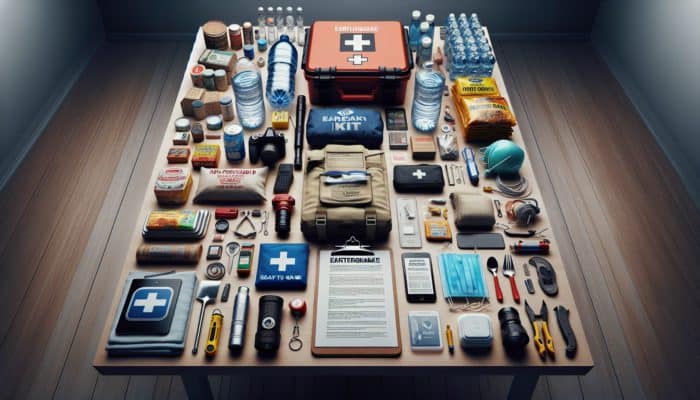Essential Strategies for Navigating Transit Disruptions Effectively
Key Items to Include in Your Essential Emergency Transit Kit

To successfully navigate the challenges presented by public transit failures, it is crucial to have a well-prepared emergency kit. This kit should encompass basic supplies such as water and nutritious snacks to sustain your energy during prolonged delays. A reliable flashlight is essential, ensuring visibility in unexpected situations. Including a first-aid kit is vital for addressing minor injuries and maintaining health and comfort. Since many individuals depend on their smartphones for real-time transit updates, a portable charger is a must-have; keeping your device charged allows you to stay connected and informed. Additionally, consider packing a lightweight blanket or a jacket for warmth while you wait, particularly in outdoor or uncomfortable conditions.
Beyond the basic necessities, think about personal comfort items that can enhance your experience during extended waits. A book or a puzzle can serve as excellent distractions, helping to pass the time more pleasantly. It is also crucial to pack necessary medications and toiletries, especially for lengthy journeys. Having small bills and coins accessible for any unplanned purchases, whether for food or alternative transportation, is also wise. Organizing your kit in a compact, easily reachable bag ensures you can swiftly access what you need during disruptions, empowering you to face any situation with confidence and readiness.
Effective Methods for Staying Informed About Transit Service Changes
Maintaining awareness of service changes is vital for effectively managing challenges within public transit systems. Leverage transit apps that offer real-time updates and alerts customized to your specific routes. Many metropolitan transit systems provide dedicated applications that not only track the status of your bus or train but also send notifications regarding delays or service interruptions. By opting into these alerts, you can receive prompt updates directly on your mobile device, enabling you to proactively adjust your travel plans and minimize disruption.
Another valuable strategy is to follow transit authorities on social media platforms such as Twitter and Facebook. These channels often deliver the latest updates in real-time, frequently faster than traditional news sources. Additionally, routinely checking official websites for scheduled changes and disruptions is a smart practice, particularly for longer journeys where awareness of connecting services or diversions is critical. Make it a habit to consult these resources prior to your commute, preparing you for any potential issues that may arise.
Important Considerations for Planning Alternative Routes and Transportation Options
Exploring alternative public transit options in advance can prove invaluable during crisis situations. Familiarize yourself with nearby bus stops, train stations, and different routes so that you can navigate around unexpected service failures efficiently. It’s equally important to be aware of possible walking or cycling routes that could serve as effective backup options. Having a mental map of your surroundings significantly enhances your decision-making abilities during delays, enabling you to swiftly adjust your travel plans as needed.
Moreover, consider keeping a readily accessible list of taxi or ride-sharing services on your mobile device. Services like Uber and Lyft can be lifesavers when public transport is unavailable, allowing you to reach your destination without significant delays. If you reside in an area prone to frequent transit failures, exploring carpooling options with colleagues or friends can provide reliable alternatives, ultimately streamlining your journey. By planning ahead and maintaining flexibility, you can significantly reduce the stress associated with transit disruptions.
Techniques for Managing Stress and Remaining Composed During Delays

Effectively managing stress during transit delays involves both mental and physical strategies. Practicing deep breathing techniques can significantly alleviate anxiety levels. Take a moment to focus on your breath—inhale deeply, hold for a moment, and then exhale slowly—to help calm your nerves and regain your focus. Additionally, incorporating mindfulness practices can cultivate a sense of peace and presence, allowing you to cope more effectively with unexpected situations.
Bringing forms of entertainment, such as a book or portable games, can help redirect your attention from the frustrations of waiting. Engaging in these activities can transform an inconvenient delay into a more enjoyable experience. Maintaining a positive mindset is crucial; remind yourself that delays often occur due to factors beyond your control. Cultivating patience and a sense of humor about the situation can significantly enhance your overall experience during unexpected disruptions, helping you make the most of a challenging circumstance.
Insights from Experts on Successfully Navigating Public Transit Failures
Expert Recommendations for Coping with Long Transit Delays
Professionals recommend several effective strategies for managing long delays within public transit systems. Real-world examples underscore the significance of adopting a flexible mindset. For instance, during a city-wide transit strike, commuters who proactively planned by familiarizing themselves with alternative routes managed to significantly reduce their travel times. Having a backup plan means more than just knowing alternative paths; it involves being mentally prepared to adapt when situations do not unfold as expected.
The psychological impact of delays can be considerable, often leading to frustration and anxiety. Experts suggest taking proactive measures to maintain your patience. Engaging with fellow commuters—sharing experiences or simply conversing—can foster a sense of community and connection. Additionally, practical strategies such as bringing a book, music, or snacks can serve as distractions from the stress of waiting. Recognizing that delays are a shared experience can empower you, enhance connections with others, and mitigate the sense of isolation that often accompanies unexpected disruptions.
Advocating for Enhanced Transit Services

Advocating for improved transit services is essential for achieving long-term enhancements in public transportation systems. Joining local transit advocacy groups presents a platform to express your concerns and propose viable solutions. Actively participating in public meetings and community forums organized by transit authorities can directly influence decision-making processes. Engaging with these groups raises awareness about critical issues and connects you with others who share similar interests and concerns.
Writing letters to your representatives amplifies your voice and can create a significant impact. Clearly articulate your experiences and propose ways to enhance public transit services. When possible, include personal anecdotes that illustrate the challenges faced during transit failures. By sharing these insights, you can raise awareness and demonstrate the urgency for improvements. Collectively, advocacy efforts can yield increased funding and build more resilient transit systems that better serve community needs.
The Importance of Community Support During Transit Disruptions
Community support is invaluable during transit disruptions. Organizing community watch groups can significantly assist stranded passengers by providing information, sharing resources, and offering help when public transport fails, ensuring that no one feels isolated during challenging times. Establishing a support network enhances resilience and fosters a sense of belonging among commuters, which is crucial in moments of uncertainty.
Sharing resources and information with fellow travelers can help alleviate stress during delays. Simple acts, such as offering a phone charger, snacks, or travel advice, can create a supportive environment where everyone feels empowered. Promoting a sense of community can transform an unpleasant experience into one of collaboration and camaraderie, turning delays into opportunities for connection. Initiating community support initiatives can also raise awareness and preparedness for future transit failures.
Leveraging Technology During Transit Failures
In today’s digital age, technology serves as an essential ally during transit failures. Utilizing real-time update apps can keep you informed about the latest developments regarding service disruptions. Many of these applications provide alerts about delays, cancellations, and alternative routes, enabling you to make informed decisions on the go. The integration of navigation tools can also assist commuters in identifying the fastest alternative routes, lessening the impact of delays and disruptions.
Digital platforms can facilitate community support during disruptions. Online forums and social media groups allow commuters to share information, tips, and resources in real-time. For example, if a major train line is down, fellow passengers might share alternative bus routes or effective carpool options. By leveraging technology, not only can you stay informed, but you can also forge connections with other travelers, enhancing overall resilience during public transit failures.
Preparing for Future Transit Disruptions Effectively
Preparing for future transit disruptions involves developing a comprehensive personal emergency plan. Understanding the common issues within your local transit system helps you anticipate potential challenges effectively. Stay updated about local transit news and planned maintenance by subscribing to newsletters from your transit authority. This proactive approach can provide valuable insights into when to expect disruptions, allowing you to plan your travels accordingly.
Additionally, participating in workshops or training sessions focused on transit resilience can equip you with practical strategies to handle unexpected events. These educational opportunities often cover vital topics such as route planning, emergency protocols, and community support initiatives. Engaging with your community in these areas not only prepares you for upcoming disruptions but also enhances your overall commuting experience by fostering a culture of resilience and preparedness.
Effective Coping Strategies for Unforeseen Transit Delays
Top Techniques for Managing Stress During Delays
Effectively managing stress during unforeseen delays is crucial for maintaining your overall well-being. Incorporating deep breathing exercises into your routine can significantly reduce anxiety levels. By concentrating on your breath, you create a calming effect that soothes your nerves. Additionally, consider listening to music or podcasts to distract yourself from frustration. These auditory experiences can transport you away from immediate stressors, helping to lighten your mood during delays.
Engaging in mindfulness techniques is another effective option. Methods such as visualizing a peaceful scene or practicing gratitude can help shift your focus from the delay to more positive thoughts. Acknowledging your feelings and understanding that they are valid can also be a powerful coping mechanism. Embracing your emotions rather than suppressing them will ease your navigation through the challenges posed by public transit failures, ultimately enhancing your resilience in such situations.
Maximizing Your Waiting Time Effectively
When faced with unexpected delays, using your time efficiently can transform a frustrating situation into a productive one. Consider diving into a book or listening to an audiobook to immerse yourself in a different narrative. Engaging your mind can make the waiting period feel less burdensome and more enjoyable. Alternatively, use this time to work on a hobby or craft project, directing your energy into something creative and enjoyable that can lift your spirits.
Planning or organizing future activities can also be a constructive way to utilize your time. Whether it involves mapping out your week or exploring potential new places to visit, turning delays into planning sessions can significantly enhance your productivity. Embrace this time as a unique opportunity to reflect on your goals or strategize your next steps, and you’ll emerge from the experience feeling accomplished rather than frustrated.
Enhancing Your Experience Through Technology During Delays
Technology can greatly improve your experience during transit delays. Downloading entertainment apps for offline use ensures you can access movies, shows, or games even without an internet connection. This is particularly beneficial during long delays where boredom can easily set in. Additionally, using productivity apps to work remotely can help you stay on top of your responsibilities, allowing you to utilize your waiting time productively instead of feeling idle.
Connecting with friends or family through messaging apps keeps you socially engaged during delays. Sharing your experiences or simply having a chat can provide a sense of normalcy amidst the chaos of transit failures. Utilizing technology in this manner not only helps manage stress but also fosters connections that can enhance your overall experience during unexpected disruptions.
Essential Safety Measures During Transit Failures
Crucial Actions to Take in Case of an Emergency
In an emergency during public transit failures, adhering to instructions from transit staff and emergency responders is paramount. Remaining calm is essential; maintaining your composure allows you to assess the situation more clearly and respond appropriately. If safe, assisting others can create a supportive atmosphere amidst chaos. Stay aware of your surroundings and identify emergency exits and safety equipment on transit vehicles. Familiarizing yourself with these safety features in advance can save valuable time during an actual emergency.
In situations where evacuation may be necessary, prioritize keeping your belongings, but do not let them impede your escape. Always remember that personal safety takes precedence over material possessions. By staying calm and collected, you can help others feel more secure, contributing to a safer environment. Adopting these practices prepares you for a range of emergencies that may arise unexpectedly during transit disruptions, ensuring you are ready to take immediate action.
Strategies for Protecting Yourself and Your Belongings
Safeguarding yourself and your belongings during transit failures requires vigilance and common sense. Keep your possessions secure and within sight at all times. Using bags that can be easily fastened or carried close to your body can help deter theft and maintain the safety of your belongings. Being aware of your surroundings is critical; stay alert and take note of any suspicious behavior. If you observe anything concerning, do not hesitate to report it to transit staff or authorities for assistance.
Proactive measures can significantly enhance your safety. Avoid displaying valuable items such as smartphones or expensive jewelry in crowded areas. If you feel uncomfortable or threatened, seek help from transit staff or fellow passengers. By remaining vigilant and taking precautions, you create a safer experience during transit disruptions, ensuring both you and your belongings are well protected throughout your journey.
Ensuring Personal Safety in Crowded Situations
Maintaining personal safety in crowded situations is vital, especially during transit failures. Stay close to exits or other escape routes to ensure quick access to safety if necessary. This strategy is particularly crucial in emergencies where swift action may be required. Avoid pushing or shoving in crowded areas to prevent accidents; maintaining a calm demeanor encourages others to follow suit and contributes to an overall sense of safety.
Keeping a safe distance from others helps maintain personal space and minimizes the risk of injury. If you start to feel claustrophobic or uncomfortable, try to navigate toward less crowded areas. In situations where personal safety is compromised, calmly communicate your needs to transit staff or fellow commuters. By taking these proactive measures, you can significantly enhance your personal safety and overall well-being during unexpected transit disruptions, ensuring a smoother experience.
Research-Backed Advantages of Overcoming Public Transit Failures
Psychological Benefits of Resilience in Transit Situations
Resilience fosters numerous psychological benefits that can enhance your overall well-being, particularly when overcoming public transit failures. Real-world examples demonstrate how commuters who have faced and navigated transit disruptions often develop greater resilience over time. These individuals report increased confidence and a heightened ability to adapt to unforeseen circumstances. Facing challenges head-on can cultivate a stronger sense of self and improve coping mechanisms, offering long-term benefits.
Experts indicate that overcoming transit failures helps build mental toughness, motivating individuals to approach future challenges proactively. Taking actionable steps, such as reflecting on past experiences and recognizing personal growth, can reinforce this newfound resilience. Setting small, achievable goals during transit disruptions can also promote a sense of accomplishment, boosting your overall confidence in navigating future challenges and making you more adept at handling adversity.
Learning from Failures to Improve Future Planning
Analyzing past transit failures can provide significant insights for enhancing future planning efforts. By identifying patterns in delays or service disruptions, you can develop more effective contingency plans. For example, if certain routes frequently face disruptions during peak hours, you can adjust your travel schedule or consider alternative paths accordingly. This proactive strategy not only minimizes the impact of future disruptions but also enhances your overall travel efficiency.
Utilizing failures as learning opportunities is essential for growth and improvement. Reflecting on your experiences can help you discern which strategies were effective and which were not, allowing you to refine your transit approaches accordingly. Documenting these lessons serves as a valuable resource for future reference, enabling you to enhance your overall transit strategy. By embracing failures as an integral part of your commuting experience, you cultivate resilience and adaptability, ensuring better preparation for whatever challenges may arise.
The Impact of Transit Failures on Community Cohesion
Transit failures often act as catalysts for fostering community cohesion. When faced with disruptions, individuals from diverse backgrounds unite to navigate challenges collectively. Shared experiences during transit failures encourage empathy and support among commuters, allowing them to bond over their collective struggles. These interactions can lead to the emergence of community initiatives aimed at improving local transit services, thereby enhancing resilience and collaboration.
Moreover, transit failures frequently galvanize citizens into action, prompting them to advocate for better services and infrastructure. By joining forces, communities can tackle common issues and push for improvements that benefit all residents. Initiatives born from these shared experiences often lead to stronger connections among residents, fostering a sense of solidarity in the face of adversity. This collaborative spirit reinforces community ties, enhancing overall resilience and ensuring neighborhoods remain supportive environments even during challenging times.
Practical Guidelines for Managing Transit Failures Effectively
Best Practices for Staying Comfortable During Delays
Maintaining comfort during transit failures involves several practical strategies. Dressing in layers is essential, as it enables you to adapt to fluctuating temperatures throughout your journey. Opt for breathable fabrics to keep yourself cool, and keep a lightweight jacket or sweater handy for warmth when necessary. Additionally, packing a small blanket can provide extra comfort during prolonged waits, especially in chilly environments or crowded areas.
Consider bringing a portable fan or a cooling towel during hot weather to maintain comfort. These items can help regulate your body temperature and significantly enhance your overall experience while waiting. Staying hydrated is also crucial; make sure you have enough water to keep yourself refreshed. Being proactive about your comfort needs can substantially reduce the stress associated with transit failures, enabling a more pleasant commuting experience.
Maintaining Hygiene During Extended Waiting Periods
Upholding hygiene during lengthy waits is essential for your well-being and that of those around you. Packing essential hygiene items such as hand sanitizer and wet wipes can help you stay clean and comfortable during delays. Regularly sanitizing your hands, particularly after touching shared surfaces, can help prevent the spread of germs and support your overall health during transit disruptions.
Using disposable masks can also protect you and others, especially in crowded situations where close contact is unavoidable. Keeping a small travel-sized deodorant or body spray can help you stay fresh throughout your wait. Prioritizing good hygiene not only contributes to your comfort but also promotes a healthier environment for fellow commuters. By emphasizing cleanliness, you can navigate transit failures with greater ease and confidence, enhancing your commuting experience.
Optimizing Space and Resources During Delays
Efficiently utilizing space and resources can significantly enhance your experience during transit failures. Organizing your belongings in a compact, easily accessible manner allows for quick retrieval, which is crucial in times of uncertainty. Consider using multi-functional bags that allow you to store supplies while maximizing space. Sharing resources, such as chargers or snacks, can foster a sense of community among fellow passengers and improve everyone’s experience during delays.
Optimizing the use of transit waiting areas can also alleviate overcrowding and enhance comfort. Finding a spot that offers comfort while still allowing personal space can significantly improve your waiting experience. If possible, choose areas with seating and access to amenities such as restrooms and food services. By strategically using space, you not only enhance your own comfort but also contribute to a more pleasant environment for all commuters, ensuring a smoother experience during disruptions.
Established Methods for Surviving Public Transit Failures
Effective Techniques for Staying Informed
Staying informed during transit failures relies on effective communication strategies. Real-world examples emphasize the importance of utilizing multiple channels for timely updates. For instance, commuters who rely solely on traditional news sources may miss crucial real-time information from social media updates or transit apps. By diversifying your information sources, you can develop a comprehensive understanding of the situation, enabling better preparedness and response.
Experts suggest setting up notifications for transit apps and social media pages to receive immediate alerts about delays or service changes. Engaging with community forums can also provide valuable insights from fellow commuters. By actively participating in these discussions, you can share knowledge and remain connected with others facing similar challenges. This approach keeps you informed while fostering a sense of community during transit failures, thereby enhancing your overall experience.
Optimizing Your Commute During Failures
Maximizing your commute during failures requires flexibility and adaptability. Developing a flexible commuting schedule enables you to accommodate potential delays while ensuring timely arrivals at your destination. Consider leaving earlier or later than usual during peak travel times to avoid congestion and reduce the likelihood of significant disruptions.
Utilizing real-time transit apps can help you identify the quickest routes to your destination. These applications often feature functionalities that allow you to assess current conditions and select the best available alternatives. Carpooling or ride-sharing can also serve as effective backup options during major transit failures, providing a reliable transportation means when public systems are down. By remaining flexible and proactive, you can greatly enhance your commuting experience and minimize the impact of unexpected delays.
Building a Support Network for Transit Challenges
Creating a support network to address transit challenges is essential for navigating disruptions effectively. Joining online forums or social media groups focused on transit issues presents an opportunity to exchange tips, strategies, and experiences with fellow commuters. This collaborative environment fosters a sense of community and support, empowering individuals to share their knowledge and resources during challenging times, thereby enhancing overall resilience.
Building connections with friends or colleagues can create a reliable support system. Sharing information about transit conditions or coordinating alternate travel plans during disruptions can be beneficial. Through collaboration, you can develop strategies that improve your overall commuting experience, ensuring that you are not alone in facing transit challenges. Establishing this network not only prepares you for future obstacles but also promotes a sense of solidarity among commuters, simplifying the navigation of disruptions together.
Long-Term Solutions for Addressing Public Transit Failures
Key Components of Effective Transit Systems
Effective transit systems rely on several crucial components, including a focus on infrastructure, reliability, and capacity. Investing in modern infrastructure significantly enhances the overall reliability of public transit. For instance, cities prioritizing upgrades to their rail systems often see improved punctuality and increased passenger satisfaction. Implementing modern technologies to optimize service management, such as predictive analytics for maintenance and routing, can also enhance transit efficiency and reliability.
Another fundamental aspect is fostering public-private partnerships to enhance funding and innovation in transit solutions. Collaborations between governmental entities and private firms can yield innovative solutions to common challenges in public transport. Sustainable practices, such as integrating electric or hybrid buses, can also improve service reliability while minimizing environmental impacts. By focusing on these elements, cities can build robust transit systems that better serve their communities and respond to their evolving needs.
Enhancing Transit Services Through Public Engagement
Public participation is vital for enhancing transit services. Encouraging community feedback through surveys and town hall meetings allows citizens to voice their concerns and suggestions directly to decision-makers. When transit authorities actively involve the public in decision-making processes, they gain a clearer understanding of community needs and priorities, leading to more effective solutions and services.
Involving citizens in transit planning not only empowers them but also fosters a sense of ownership over local transit systems. When individuals feel that their voices matter, they are more likely to advocate for improvements and participate in community initiatives aimed at enhancing transit services. Utilizing public input to prioritize enhancements can result in more responsive and efficient transit services that cater to the needs of all users, ultimately benefiting the entire community.
The Importance of Sustainable Transit Solutions
Sustainable transit solutions are essential for long-term success in public transportation. Promoting eco-friendly options, such as electric buses or trams, can significantly reduce carbon footprints while improving air quality in urban environments. Furthermore, developing integrated transport networks helps decrease reliance on single modes of transport, fostering a more holistic commuting approach that benefits both the environment and commuters.
Advocating for policies that support long-term sustainability in transit systems is equally important. This advocacy may involve promoting investments in infrastructure that accommodates various transportation forms, such as cycling and walking paths, to create a more interconnected transit ecosystem. By prioritizing sustainability, cities can establish transit solutions that not only meet current demands but also cater to future generations, ensuring a cleaner and more efficient transportation system for all.
Diverse Funding Models for Long-Term Transit Success
Exploring diverse funding sources is crucial for supporting long-term transit success. Funding can originate from various avenues, including taxes, fares, and grants. Implementing innovative financing models, such as public-private partnerships, can also inject much-needed capital into transit projects. These collaborations often lead to increased investment and innovation, ensuring that transit systems remain efficient and responsive to community needs while providing reliable services.
Ensuring transparency and accountability in fund allocation is vital for sustained transit improvements. Citizens should be informed about how funds are utilized and the impact they have on public transport services. By fostering trust and transparency, cities can cultivate stronger relationships with their communities, encouraging public support for future transit initiatives and enhancing the overall efficacy of public transit systems.
Building Personal Resilience in the Face of Transit Failures
Core Elements of Personal Resilience
Developing personal resilience involves nurturing several core components essential for coping with challenges. A positive mindset is crucial for dealing with unexpected disruptions. Embracing challenges as opportunities for growth empowers you to approach difficulties with confidence and determination. Establishing a support system made up of friends, family, and colleagues is equally important, as having a strong network provides emotional support during tough times and helps you navigate through challenges.
Practicing adaptability and flexibility in your daily routines further enhances your resilience. Being open to change allows you to adjust your plans and expectations, thereby reducing stress when facing unforeseen challenges. By focusing on these core components, you create a solid foundation for navigating the unpredictable nature of public transit failures and other life challenges, ultimately improving your capacity to cope with adversity.
Fostering a Resilient Commuting Mindset
Fostering a resilient commuting mindset begins with setting realistic expectations for your journey. Acknowledge that delays can occur, and mentally preparing for them can significantly alleviate frustration. Focus on elements within your control, such as your attitude and responses to disruptions. This proactive approach allows you to maintain a sense of agency, even in the face of challenges, enhancing your overall commuting experience.
Incorporating positive affirmations into your daily routine can also help cultivate a resilient mindset. Remind yourself of your strengths and past successes to reinforce your ability to handle unexpected situations. By focusing on positivity and proactive thinking, you can develop a more resilient approach to commuting, ultimately enhancing your experience during public transit failures and empowering you to navigate challenges with greater ease.
Techniques for Maintaining Well-Being During Delays
Maintaining well-being during delays is essential for a positive commuting experience. Engaging in physical activities, such as stretching or walking during waits, can help alleviate tension and stress. Taking short breaks to move your body promotes circulation and can elevate your mood, making the waiting experience more manageable.
Practicing relaxation techniques like meditation or yoga can also enhance your well-being during transit disruptions. These practices foster a sense of calm and help manage anxiety levels, equipping you with tools to cope more effectively. Connecting with others during delays, whether through conversation or shared experiences, can also provide emotional support, reinforcing a sense of community even amidst challenging circumstances.
Frequently Asked Questions
What essential items should I include in my emergency transit kit?
Your emergency transit kit should contain essentials such as water, nutritious snacks, a flashlight, a first-aid kit, a portable charger, and personal comfort items like a blanket or jacket to ensure you are prepared for any unexpected situation.
How can I stay updated on transit service changes effectively?
Utilize transit apps, subscribe to service alerts, and follow transit authorities on social media for timely updates regarding service changes and disruptions, allowing you to remain informed and adjust your travel plans accordingly.
What alternative transport options should I consider during disruptions?
Familiarize yourself with nearby bus routes, cycling paths, and keep a list of taxi or ride-sharing services to use during transit failures, ensuring you have backup options readily available when needed.
How can I effectively manage stress during transit delays?
Implement deep-breathing exercises, practice mindfulness, and bring entertainment, such as books or music, to distract yourself and alleviate anxiety during delays, enhancing your overall experience.
What strategies do experts recommend for handling long delays?
Experts suggest maintaining a flexible mindset, engaging with fellow commuters, and utilizing distractions such as snacks and entertainment to cope effectively during long waits, ensuring you remain calm and collected.
How can I advocate for better transit services in my community?
Join local advocacy groups, participate in public meetings, and write to your representatives to voice your concerns and push for improvements in transit services, ensuring your voice is heard in the decision-making process.
What role does community support play during transit failures?
Community support assists stranded passengers by organizing help, sharing resources, and fostering connections that enhance collective resilience during transit disruptions, creating a supportive network for those affected.
How can technology assist me during transit failures?
Leverage apps for real-time updates, utilize navigation tools for alternative routes, and engage in digital platforms for community support during transit disruptions, enhancing your overall commuting experience through technology.
What steps should I take in case of an emergency on transit?
Follow the instructions of transit staff and emergency responders, remain calm, and be aware of your surroundings, including emergency exits and safety equipment, to ensure your safety during emergencies.
How can I ensure my personal safety during crowded situations?
Stay close to exits, maintain personal space, and avoid aggressive interactions to enhance your safety in crowded transit environments, promoting a safer experience for yourself and others.
Explore our world on X!
The post Surviving Public Transit Failure: A Universal Guide appeared first on Survival Bite.
The Article Public Transit Failure: Your Essential Survival Guide Was Found On https://limitsofstrategy.com








